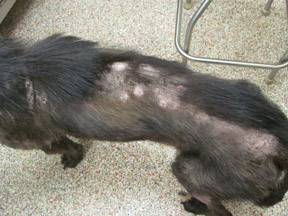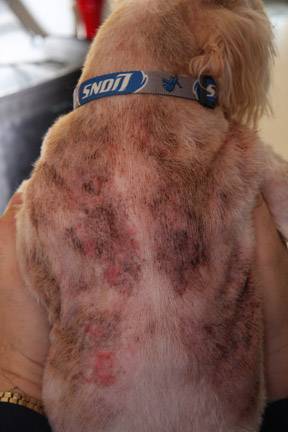Sebaceous Adenitis in Dogs
What is a Sebaceous Gland?
Everyone has heard skin described as dry, oily, or normal, which refers to the amount of natural oil on the skin surface. The oils of the skin are important moisturizers as they hold water inside the skin and prevent its evaporation. The oil also acts as an important part of the skin’s protective barrier keeping irritants or even infectious organisms away from the skin cells below. The skin’s barrier function is complex and multi-faceted but it is the oil portion that concerns us with sebaceous adenitis.
The oils that coat the skin come from “sebaceous glands” which are oil secreting glands that feed into the hair follicles. Hair follicles are small holes from which a hair grows. The oil is secreted into the follicle, eventually making its way out of the follicle and onto the surface of the skin.
Sebaceous Adenitis Means Inflammation of the Sebaceous Glands
In early stages of sebaceous adenitis, skin biopsies show glands in the throes of the inflammatory process. In later stages, the inflammation has more or less destroyed the glands so they are simply absent from the biopsy sample. Knowing the stage of the disease is important in determining what therapy will help: if the inflammation is still active, there is some chance at saving at least some of the glands.

No one knows what causes sebaceous adenitis, but we know that certain breeds are predisposed (which means there is most likely a genetic component). In the Standard Poodle, sebaceous adenitis is likely a recessive genetic trait, though not all dogs who are genetically able to express the disease will actually go on to actually express the disease. We think a similar situation exists for the Akita.
Affected dogs should be registered with the Orthopedic Foundation for Animals so that the heredity of the trait can be tracked. Other breeds that seem to have a genetic predisposition to sebaceous adenitis include the Chow Chow, Samoyed, Viszla, and Havanese (particularly prone to lesions on the ears) but any dog breed can be affected.
What Does an Affected Dog Look Like?
This depends a great deal on whether the hair is short or more plush/fluffy. The condition is generally not itchy unless there is an accompanying bacterial infection in the skin, which probably happens in about 40% of affected dogs. In other words, sebaceous adenitis may or may not be itchy, depending on whether there is a concurrent infection.
For short-haired dogs, a fine white dandruff begins on the head and ears that ultimately progress to the whole body.

Scaling areas tend to be round or S-shaped. For long-haired or plush-coated breeds, the scale is most obvious as a clump of dandruff sticking to a group of hairs. The coat is dull and brittle and tends to develop a reddish tint. In time, bald spots develop. Again, usually, the head is where problems start.
Biopsy of the skin is required for diagnosis.
Treatment
Response to therapy largely depends on whether there are still living sebaceous glands in the biopsy sample or not. If there are no glands left and they have all been destroyed, it will be much harder to get a response though it is possible for glands to regenerate with treatment. The inflammation that destroyed (or is destroying) the sebaceous glands must be stopped. Furthermore, new hair growth depends on a coat of sebum (skin oil), so if the patient’s skin is not making adequate skin oil, the oil must be replaced.
Topical
Oil replacement treatments are performed frequently at first and taper down to less frequent applications after the first month. Every dermatologist seems to have their own preferred regimen, so here are some typical recommendations:
Mineral oil, mineral bath oil (such as Alpha Keri®), or propylene glycol mixed with water, sprayed onto the coat or affected area of the coat, rubbed in, and shampooed out with a degreasing shampoo after a one-hour soak.

This is performed typically once a week for the first month, then as needed. There are topical products that enhance the barrier function of the skin, and these can be used to assist therapy. Omega 6 fatty acid topicals are also becoming more popular as an easy way to replenish skin oil as they are easily applied as a top spot.
Oral Supplements
Oral omega-3 fatty acids are almost always included in the treatment regimen. Vitamin A has been advocated for sebaceous adenitis but seems to be fading out of popularity with the advent of other oral treatments (see below).
Oral Medication
Cyclosporine seems to be at the heart of treatment for the more severely affected dogs; further, on cyclosporine, dogs with only two percent of their sebaceous glands left have been able to increase this number to 40 percent. Cyclosporine is an immunomodulator that is able to suppress the inflammation that is destroying the sebaceous glands. Patients may need ongoing low dose therapy.
Synthetic retinoids have held a great deal of promise in treating sebaceous adenines, but they are tightly regulated by the government and are not readily available for veterinary patients.
Immunomodulation with doxycycline is an emerging therapy but is still in the investigational stage. Doxycycline is, first and foremost, an antibiotic but has numerous immunomodulating properties as well and is used widely to treat immune-mediated disease.

Managing a dog with this condition can be labor-intensive for the dog’s lifespan. The amount of work needed at home depends on the individual dog’s response to therapy. Marked improvement is typically realized within 4 months of treatment, but it is important to realize this can be a high-maintenance skin disease.
